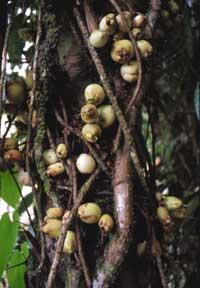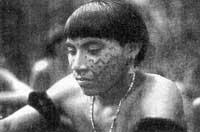The tropical rainforest, the prosperity of life (and II)
1996/02/01 Arturo Elosegi Irurtia - Ekologiako katedradunaZientzia eta Teknologia Fakultatea. EHU Iturria: Elhuyar aldizkaria
Operation of the rain forest
In addition to diversity, tropical rain forests are the most productive ecosystems in the world. Although the soil is poor, food is recovered thanks to the developed micorrizes of the trees. The water to taste, warm and stable temperature, is very easy to photosynthesis of the plants. Tropical rainforests plants can produce 4 kg of organic matter per square meter per year, three times the primary production of our forests. However, the Amazon is not at all a global lung: in most rainforests, all the oxygen produced by the plants is used by its consumers and decomposers.
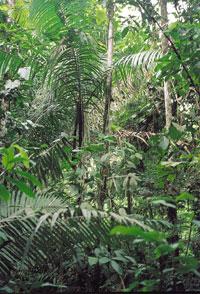
The decomposition is very fast, since in the humid heat the metabolism of bacteria and fungi is accelerated. Therefore, in most cases, production and decomposition are balanced and the amount of organic matter does not increase over time. The soil usually has little humus and is much less corrupt trunk and litter than in temperate forests.
We have heard that both in the street and in the scientific environment, tropical rains are very stable and small changes occur in them. And if that is true, it is no more than half of the truth. In the tropical forests the seasons are not as defined as in the temperate forests and most trees maintain their leaves throughout the year. However, most plants have a marked phenology and, in the absence of great temperature changes, the small peaks of humidity or temperature favor the flowering or the fall of the fruits. Thus, the living creatures of the jungles also suffer from abundant food stations and food shortages, as elsewhere. In the same way, although it was considered that the populations of the coastal forests were stable over time, today it has been possible to verify that they can undergo drastic changes. Pests are not exclusive to temperate regions.
At one time, given the fertility of the forests, it was considered that they could be recovered quickly, so they seemed very useful for exploitation. Today we know that these convictions had little foundation: the most common tropical soils are latosols, the poor in food and soil when it comes to eliminating the forest suffer a very rapid damage. If there is no shade, the intense sun covers the floor forming a hard crust. From there, rainwater will not be able to filter on the ground and runoff will cause a great erosion, as will the badland in arid landscapes. Unlike the jungles of our latitudes, tropical rains are very sensitive and once lost they will hardly be recovered.
Dynamics of the gaps
With the passage of time and for different reasons, they are created clear in the jungle. The aging and death of a giant tree, the calcination of three or four trees by lightning, or the reduction of hectares by cyclones so common in the tropics, in any mature forest are spread clear. And knowing its dynamics is fundamental to understand the functioning of the jungle.
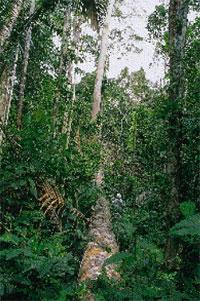
We can classify forest trees in two large groups: pioneers and climate. The seeds of pioneering trees are cooled to strong suns and the young plants grow at full speed, but cannot live in the shade; they begin to bloom from a very young age and produce large quantities of seeds that the wind will scatter in the distance; they have green wood and large leaves, little protected against animals; despite their rapid growth (the South American raft can grow 5 meters per year), they grow old soon and die.
The climatic trees, on the other hand, are of slow growth and late maturity, produce less seeds and do not have too much dispersal capacity, but are able to cool in the shadows of the underwood and the vegetation can last for many years, when one of the main trees falls; the climatic species can suffer shadows in the young and survive by growing in strong suns on the forest; the slow growth trees are much longer than the 200 years.
The functioning of the forest is based on the different ecological characteristics of both groups. When a small clearing spreads, there is little light in the underwood and pioneering trees cannot germinate, if some climate tree is near, it will fill one of its plants. However, if the calvary is greater, the illumination is too hard for climatic plants and the pioneering trees predominate. These can grow in high densities forming a monocapa forest, but their seeds cannot germinate under the shade of the parents, and when the climatic ones are in the area they will be replaced.
Therefore, when a clearing is created, the seeds and plants existing in the soil, the type of forests that surround it, the dimension of calvary, the lighting that arrives and the specific characteristics of the soil, condition its growth. Thus, when we see any forest (and the temperate forests are not very different), we can identify different spots: clearings of different ages or in different steps towards a climatic situation. This increases the diversity of the forest.
Pluvial forests today
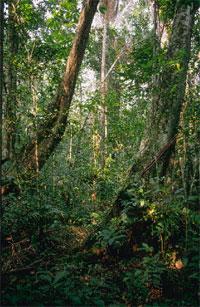
The human being has lived for a long time in tropical rain forests and has exploited them differently. Some ethnicities were mere collectors and hunters who, like all predators, covered ample areas of life, in low density. Others, however, carried out a fontanera agriculture: they opened with fire a small clearing in the jungle, where they collected the crops for two or three years, planted usable trees before pouring the soil and they went to another place. With this system, the forest has been maintained, therefore, as a changing mosaic: a small agricultural area, a secondary forest (areas used in previous years) for fruit harvesting and a primary or climatic jungle for hunting and recovery.
Fontanera agriculture was then very widespread: some experts believe that most of the areas of the Amazon that today we consider primary would be secondary forests (occasionally cut). It seems that when Europeans arrived in America millions of Indians lived in their rain forests, the majority of them peasants. However, the modern man caused them more damage than what the jungle could do: several deadly diseases for them. Half of the South American population, and more than 90% of the jungles, was banned by flu, syphilis, typhus and other diseases carried by westerners. Only hunters of collectors who lived in the most hidden areas were saved, and these also live in danger today.
Although not all the authors agree fully on the importance of farming, almost all agree in saying that they sometimes found an adequate system of exploitation, similar to the dynamics of the forest itself. However, European colonizers radically changed this balance. A totally irrational exploitation was promoted with the aim of obtaining maximum money in the short term. Many giant trees of rainforests, such as mahogany, are of good wood and are worth a fortune. In its search, the forest was destroyed without any predictions.
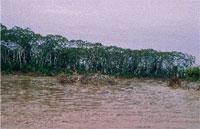
Since in our forests there are three or four main species, these are very abundant and if forest growth is allowed, they will quickly colonize any hollow. On the contrary, in the immense diversity of tropical forests, most species can be considered rare and are in a precarious situation of colonization. In the formation of large clearings, the soil is covered by two or three pioneering species. They have bad wood and their fruits are medium for animals. The overexploitation of the rich and diverse jungle replaces the poor and null secondary forest. Under these conditions, and as a result of initial deforestation, the disappearance of the entire primary forest could take thousands of years to remove the remains of deforestation.
At present this risk is known and in some places (Australia, Malaysia) more suitable operating systems have been developed. These are based on selective clearances, without in any case producing large calves and always taking care of the salvage of trees of all species of interest. It is known that this attitude generates sales problems, but it is the only way to sustainably exploit the rainforest of tropical rain.
In addition, it must be taken into account that the requirements that Europeans knew are totally different and that the agrarian systems that worked properly in the temperate regions have been catastrophic. The land of temperate latitudes, with abundant organic matter and nutrients, has taken advantage of the wealth accumulated for centuries by farmers from Europe. Adding the necessary foods to get a certain crop, the earth can take many years.
In the tropical regions, in addition to pouring the earth in a couple of years, the intense sun can calm and drag heavy rains, where arborescent crops such as banana, mango, are much better adapted, providing shade and protection to the soil. However, they continue to copy models of countries that are considered developed in many tropical countries. In Brazil, for example, there is a large deforestation to create grasses that can only be maintained for ten years. In this case, the U.S. model Far Westa has also come to the World Bank's councils to continue to provoke disasters. As long as operating systems are not developed in these countries, they will only harm the environment and the economy.

By contrast, the rainforest of tropical rain is the fastest biome in the world and in many cases with very little use. The most well-known case is that of Amazonia, but in many other places (eastern Asia, Madagascar, Central America) most of the rainfall episodes have disappeared. Most of the damage is also irreversible; although it is sometimes possible to recover the forest, all the species destroyed (and many have been) have gone forever.
The poverty of most tropical countries and the contrast with the international economy hinders the survival of these rich but fragile ecosystems. However, there are many expectations. All over the world, people are becoming aware of the importance of these forests, and in many tropical regions they can get more money by protecting forests than by exploiting them for wood; the exploitation techniques are becoming more appropriate and, above all, we are drawing more and more diverse benefits from rainforests. The future tells us.

Gai honi buruzko eduki gehiago
Elhuyarrek garatutako teknologia



